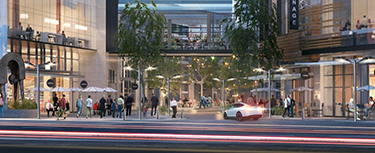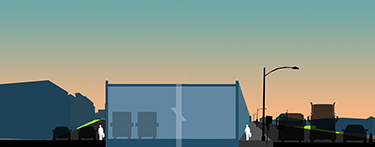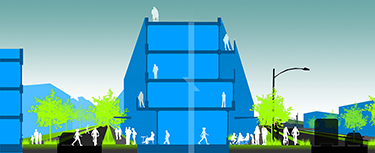|
Subscribe / Renew |
|
|
Contact Us |
|
| ► Subscribe to our Free Weekly Newsletter | |
| home | Welcome, sign in or click here to subscribe. | login |
Real Estate
| |
 |
February 22, 2018
Reimagining the urban edge along Aurora
B+H Architects

Talbot
|
At a time when the Puget Sound region is welcoming over 1,000 new residents every week, finding a home and winning the bid to purchase it, in a neighborhood where everyone else is competing to find space, is like looking for a needle in a haystack.
With water on one side and mountains on the other, developable land in and around Seattle is a finite resource, which means we need to rethink how we are using the land we do have. It’s time we stop neglecting swathes of prime real estate with eye-popping views simply because we cannot imagine they could ever be anything other than what they already are.
Oftentimes, the problem is not the location of the real estate that makes it undesirable, but the planning model itself.
The current zone-based model creates inanimate blocks with buffered, siloed uses and harsh edges. Where one use stops, the next begins, lacking a natural flow. In the built environment, separation is an artificial construct. In living systems, the boundaries are where the magic happens — when nature finds an abused, dying edge, it quickly moves to soften and reclaim it.
This is our opportunity.
As architects and designers, if we reject the tactical (zoning) approach and embrace a strategic (living) approach, we can soften neglected areas of real estate ("the edge") and catalyze the emergence of vibrant neighborhoods along our unkempt automobile-focused arterials. A strategic approach blends quantitative data with qualitative data to create a sustainable economic model for successful development.
What comes to mind when you think of Aurora Avenue North? Used car sales lots? Dilapidated motels? Big Box retailers on islands of asphalt parking? Or perhaps you recall the blocks of new senior apartments or the Asian food market or the trek you always make to the craft store? Whatever your association, it is almost certainly not an image of green laneways, landscaped sidewalks, beautiful views, bustling hubs of retail or pedestrian activity.
However, there is no reason why these things cannot exist along one of our city’s major transit corridors, especially one that happens to have spectacular views. Implementing a deliberate approach that explores the highest and best use of sites along the corridor could breathe life back into the Aurora spine, helping it to become a more desirable community where people want to live, work and visit.
We propose a six-step strategic process that blends quantitative (historic) data with qualitative (insightful) data to create a sustainable economic model for successful development
1. Begin with the people
A successful approach to rethinking development needs to start not with the real estate, but with the people. Redirect the focus on natural gathering points such as transit areas, pedestrian bridges and main cross streets.
To encourage new development along corridors and attract business, it is important to fully understand how people will arrive and move around the area now and in the future.
2. Analyze the data
Next, it's important to analyze the area's existing assets like views, proximity to transit and established neighborhoods, and ease of access to downtown. This initial assessment would consider current needs of the area such as food and beverage options, community centers and small business-focused office space.
After identifying current needs, extrapolating what the area may need or desire in the future is key.
3. Paint the vision
To gather qualitative insight and create a vision for the future, it's important to engage neighbors and other stakeholders in the community to imagine how the neighborhood could look and feel if it was softened and reclaimed.
Along Aurora, this might entail creating pocket parks and informal gathering spaces between the buildings, widening sidewalks, using landscaping and public art to buffer pedestrians from cars, establishing protected bike lanes, installing weather-protected transit stops, improving alleys as pedestrian-focused laneways and even incorporating layout flexibility to building entrances by positioning them off the main street to address current security concerns while still providing main street access in anticipation of future improvements along the corridor.
4. Open the door to the future
When reimagining a neglected corridor, it is important to consider flexibility to easily accommodate future needs. For example, a future bus stop along Aurora could look radically different than today, with a cozy cafe, Amazon lockers, dry cleaning services and a grab-and-go grocery. Flexibility for growth and change is vital.
5. Create a sense of place
Streets parallel to main vehicular arteries hold an abundance of opportunity. These streets can transform into active laneways that enhance pedestrian access from interior streets to the main thoroughfare and encourage informal gatherings. These laneways create possibilities for thoughtfully designed pocket parks, neighborhood cafes and restaurants, active community centers, and lively outdoor markets.
6. Make it possible
Change on this scale is hard, but not impossible. We recognize the importance of engaging with major land owners as well as small-scale tenants. As catalysts for change, small-scale tenants tend to be more willing to try innovative approaches and take manageable risks. Change of this kind would require trust and rapport among the community to enhance Aurora's urban experience — and a shared vision can be a powerful force for change.
Additionally, encouraging the city to offer permitting incentives for affordable housing development and fast-tracking those permits could save developers hundreds of thousands of dollars and encourage build-out of desperately needed housing. This would ensure the seeds of the community are sown into the fabric of the development.
On an urban scale we are adept at creating community. For a mixed-use podium in the city of Bellevue, currently in design, we began by identifying existing market offerings, what was missing and what people were craving. From analysis and insight, we wove a narrative linking a series of needs and desired experiences, drawing people through the space and giving them reason to linger. The desired user experience informed consideration of the edge as we gently transitioned the development from bustling pedestrian activity to city street, breaking down speed and scale with layers of landscaping, sheltered seating and art.
There is no reason why the process cannot be equally effective in reverse.
As we have learned, the most successful developments are technically possible, economically feasible, politically acceptable and socially desirable. Our "reimagining the urban edge" approach for Aurora and similar corridors checks these boxes and has the potential to trigger the transformation of some of Seattle's most underutilized assets, giving them a sense of place and fostering the spirit of community that is the hallmark of Seattle's most desirable neighborhoods.
Eva Talbot is senior project designer, architect and strategist at B+H Advance Strategy in Seattle. She is steering South Lake Union's first Mandatory Housing Affordability project through permitting and has assisted in developing rezoning codes for many Seattle neighborhoods.
Other Stories:
- Building a new urban fabric along Pike-Pine
- Survey -- Martin Selig Real Estate
- Survey -- Schnitzer West
- Survey -- Urban Renaissance Group
- Survey -- Continental Properties
- Office market tightening, demand keeps rising
- Institutions take over the industrial market
- Retailers adapt to millennials, e-commerce
- Don’t get too comfortable with hotels
- 100,000 apartment units are coming — now what?
- Here’s how to solve the condominium conundrum
- Neighborhood hub emerging from old shopping center
- Moratorium has Bainbridge projects at a standstill
- We need to tackle our top public safety concern: URM buildings
- Workplace 2.0 for millennials and Gen Z
- Yesler: a model for inclusive urban development
- Seattle retools for the future at Fifth and Virginia
- A balancing act: development, transportation, place making
- Survey -- Capitol Hill Housing





